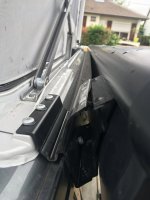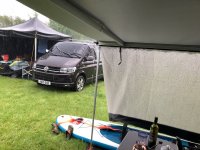Bill R
VIP Member
 Any new owners - please listen to the advice on here regarding inclement weather & the awning !
Any new owners - please listen to the advice on here regarding inclement weather & the awning !Being sure there would be hardly any wind overnight I left it up. Expecting overnight rain I lowered one corner as advised.
Not low enough ! The rain hammered down and I guess the force of the rain on the awning roof caused it to sag allowing it to pool in spite of a lowered corner.
A loud 4am bang had us awake - the weight of gathered water did its dirty deed.
So IF you leave it out in rain lower the corner to the point where it looks daft - if it doesn't look very odd you haven't lowered it enough.
Better still , wind it in. I won't take that chance again.
Now a request for advice please.
It looks like the damage may be limited to sheared rivets. I've attached a photo of the bracket at the rear where the damage has occurred.
Is this a simple fix ? We are in France and would be good not to have t bother with booking it in somewhere and I'm sure it's not a warranty claim unless it covers owner stupidity




















